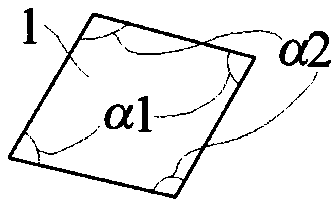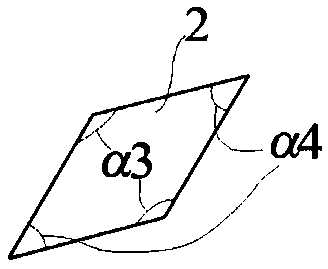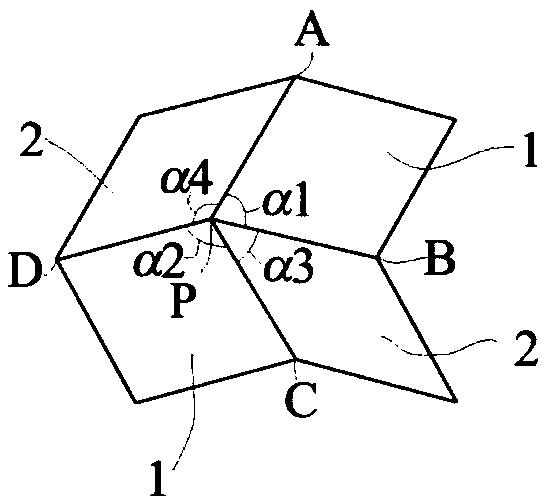Foldable structure with negative poisson ratio based on rigid origami
A negative Poisson's ratio, rigid technology, applied in the direction of cardboard articles, etc., can solve the problems of difficult to accurately control the folding and unfolding process, application restrictions, large elastic-plastic deformation of unfolding and folding materials, etc. Transport and storage, easy-to-use effects
- Summary
- Abstract
- Description
- Claims
- Application Information
AI Technical Summary
Problems solved by technology
Method used
Image
Examples
Embodiment 1
[0042] diagram 2-1 Shown is the first foldable structure A1, which consists of four basic units; Figure 2-2 is the basic unit B1 of A1; Figure 2-3 It is the folding unit C1 of A1, and the common sides connecting different parallelogram units constitute the mountain line crease and the valley line crease of folding unit C1. C1 has twelve creases in total, which are the first mountain line 1H1, the second Mountain line 1H2, third mountain line 1H3, fourth mountain line 1H4, fifth mountain line 1H5, first valley line 1V1, second valley line 1V2, third valley line 1V3, fourth valley line 1V4, fifth valley line 1V5, the sixth valley line 1V6 and the seventh valley line 1V7, wherein the first, second, third valley line and the fifth valley line intersect to form the first apex 1P1; Figures 2-4 to 2-8 is the folding process of A1, where Figure 2-4 and 2-8 Shown are the two planar states of A1.
Embodiment 2
[0044] Such as Figure 3-1 Shown is the second foldable structure A2, which consists of four basic units; Figure 3-2 is the basic unit B2 of A2; Figure 3-3 is the folding unit C2 of A2, and the common sides connecting different parallelogram units form the mountain line crease and valley line crease of folding unit C2 respectively. C2 has a total of 22 creases, which are the first mountain line 2H1, Second mountain line 2H2, third mountain line 2H3, fourth mountain line 2H4, fifth mountain line 2H5, sixth mountain line 2H6, seventh mountain line 2H7, eighth mountain line 2H8, ninth mountain line 2H9, tenth mountain line Line 2H10, Eleventh Mountain Line 2H11, Twelfth Mountain Line 2H12, First Valley Line 2V1, Second Valley Line 2V2, Third Valley Line 2V3, Fourth Valley Line 2V4, Fifth Valley Line 2V5, Sixth Valley Line Line 2V6, the seventh valley line 2V7, the eighth valley line 2V8, the ninth valley line 2V9 and the tenth valley line 2V10, where the fourth, sixth, sevent...
Embodiment 3
[0046] Such as Pic 4-1 Shown is the third foldable structure A3, which consists of four basic units; Figure 4-2 is the basic unit B3 of A3; Figure 4-3 is the folding unit C3 of A3, and the common sides connecting different parallelogram units form the mountain line creases and valley line creases of the folding unit C3 respectively. C3 has sixty-two creases in total, which are the first mountain line 3H1, Second mountain line 3H2, third mountain line 3H3, fourth mountain line 3H4, fifth mountain line 3H5, sixth mountain line 3H6, seventh mountain line 3H7, eighth mountain line 3H8, ninth mountain line 3H9, tenth mountain line Line 3H10, the eleventh mountain line 3H11, the twelfth mountain line 3H12, the thirteenth mountain line 3H13, the fourteenth mountain line 3H14, the fifteenth mountain line 3H15, the sixteenth mountain line 3H16, the seventeenth mountain line 3H17, 18th mountain line 3H18, 19th mountain line 3H19, 20th mountain line 3H20, 21st mountain line 3H21, 22...
PUM
 Login to View More
Login to View More Abstract
Description
Claims
Application Information
 Login to View More
Login to View More - R&D
- Intellectual Property
- Life Sciences
- Materials
- Tech Scout
- Unparalleled Data Quality
- Higher Quality Content
- 60% Fewer Hallucinations
Browse by: Latest US Patents, China's latest patents, Technical Efficacy Thesaurus, Application Domain, Technology Topic, Popular Technical Reports.
© 2025 PatSnap. All rights reserved.Legal|Privacy policy|Modern Slavery Act Transparency Statement|Sitemap|About US| Contact US: help@patsnap.com



